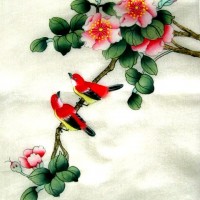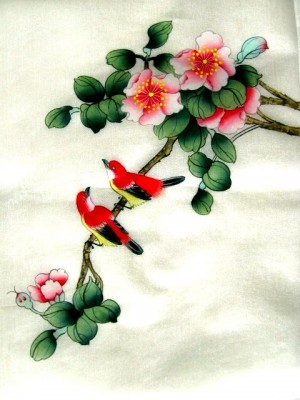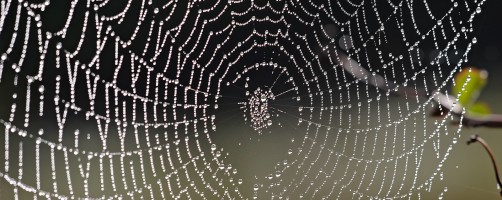A Catapiller… Lapis… and the Creator’s Hand.

 Asian silk painting is famous throughout the world for its poetic themes and vibrant colors. The traditional art form of silk painting is not only stunning, but differs greatly from watercolor and oils. In fact, it reminds me of the process and work requirements of painting an Italian fresco! Both methods transfer outlines of the drawing onto the canvas of either plaster or silk. Both methods amazingly incorporate the white color of the canvas background i.e. silk and plaster into the color palate of the image. Both methods are also characteristic for having a luminous matte finish. The shimmering appearance of silk is due to the triangular prism-like structure of the silk fiber itself, which allows the silk cloth to refract incoming light at different angles in the same manner of crystallized mineral, stone, and glass so notably used in the creation of fresco. All these shared attributes are unique and important in art design as well as aesthetically pleasing to the eye, but the most unique attributes in both art forms, is the perfect and delicate harmony created between art and nature. It reminds me of Christ and how He created all things (Colossians 1:16) and holds them together (Hebrews 1:3).
Asian silk painting is famous throughout the world for its poetic themes and vibrant colors. The traditional art form of silk painting is not only stunning, but differs greatly from watercolor and oils. In fact, it reminds me of the process and work requirements of painting an Italian fresco! Both methods transfer outlines of the drawing onto the canvas of either plaster or silk. Both methods amazingly incorporate the white color of the canvas background i.e. silk and plaster into the color palate of the image. Both methods are also characteristic for having a luminous matte finish. The shimmering appearance of silk is due to the triangular prism-like structure of the silk fiber itself, which allows the silk cloth to refract incoming light at different angles in the same manner of crystallized mineral, stone, and glass so notably used in the creation of fresco. All these shared attributes are unique and important in art design as well as aesthetically pleasing to the eye, but the most unique attributes in both art forms, is the perfect and delicate harmony created between art and nature. It reminds me of Christ and how He created all things (Colossians 1:16) and holds them together (Hebrews 1:3).
Much of the success of silk painting art design depends on quality of the silk canvas. Silk is a natural protein fiber created by the larvae of the mulberry silkworm, Bombyx mori. The silk is produced by the silkworm, a web-spinner undergoing metamorphosis, new life as a moth. Gods design for silk creation is really, incredibly fascinating. As a young child, I was quite spellbound with it. I desperately wanted a silk worm of my own to feed the leaves from my grandmothers’ ample mulberry trees.  Silk moths lay eggs and the eggs hatch and the little caterpillars or silkworms feed on fresh mulberry leaves. 35 days and 4 moltings later, the caterpillars are 10,000 times heavier than when they first emerged and are ready to begin spinning a cocoon. Each caterpillar begins spinning its cocoon or new little home by moving its head in a “figure 8” pattern. Two glands produce liquid silk and force it through openings in its head called spinnerets. Liquid silk is coated in sericin, a water-soluble protective gum that solidifies on contact with the air. Within 2–3 days, the caterpillar spins about 1 mile of filament and is completely hidden in its fluffy, cozy little cavern. At just the right time, the cocoon is harvested and then unraveled to produce one continuous thread, which makes for a stronger and more luxurious weave. Since a single thread is too fine and fragile to use, three to ten strands are spun together to form a single thread of silk.
Silk moths lay eggs and the eggs hatch and the little caterpillars or silkworms feed on fresh mulberry leaves. 35 days and 4 moltings later, the caterpillars are 10,000 times heavier than when they first emerged and are ready to begin spinning a cocoon. Each caterpillar begins spinning its cocoon or new little home by moving its head in a “figure 8” pattern. Two glands produce liquid silk and force it through openings in its head called spinnerets. Liquid silk is coated in sericin, a water-soluble protective gum that solidifies on contact with the air. Within 2–3 days, the caterpillar spins about 1 mile of filament and is completely hidden in its fluffy, cozy little cavern. At just the right time, the cocoon is harvested and then unraveled to produce one continuous thread, which makes for a stronger and more luxurious weave. Since a single thread is too fine and fragile to use, three to ten strands are spun together to form a single thread of silk.
Silks are produced by several other insects, but only the silk of moth caterpillars are been used for silk manufacturing. Other types of arthropods produce silk, most notably various arachnids such as spiders. Spider silk has recently received much attention in corporate research due to its superior tensile strength comparable to high-grade steel.
Sometimes we look for God in the dramatic or in an explosive, demonstrative action, like a firework display and God does choose to act and intervene in this manner when the need arises, but more often than not, God is found in the simplest things… the still, small voice (1 Kings 19:12), the glory of a flower, a silkworm or a spider’s web. In one of my favorite movies, Amazing Grace: The Life of William Wilberforce, there is a scene in which he having experienced what he called his “great change,” by becoming a committed Christ-follower tries to explain the metamorphosis taking place in his life. Talking to his Butler, he tells him why he is suddenly so amazed at the spider’s web, the grassy dew, the budding flower. “Did you find God, sir?” asks his servant. Wilber laments back. “I think God found me. Do you have any idea how bloody inconvenient that is?”

William Wilberforce would write in his diary soon after his conversion: “To endeavor from this moment to amend my plan for time. I hope to live more than heretofore to God’s glory and my fellow-creatures’ good”.
We pray now for our 7 fellows, 4 men and 3 ladies as they speak of their own metamorphosis. He chose them to be servants of Christ Jesus for the Gentiles and to do the work of a priest in the service of his good news. God did this so that the Holy Spirit could make the Gentiles into a holy offering, pleasing to him” (Romans 15:16).

 2. Praying through the Arabian Peninsula
2. Praying through the Arabian Peninsula 3. 24/7 Prayer
3. 24/7 Prayer One Way Ministries
One Way Ministries Prayercast
Prayercast